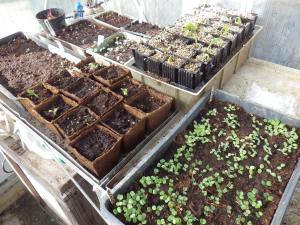You quite often hear that there’s no such thing a s a weed, just a plant in the wrong place. Well, in that case, today I have been “plant-in-the-wrong-place-ing”! It’s true, that botanically there is no definition of a weed, but all gardeners know exactly what they are in their own garden.
A few weeks ago, the hens got into the onion bed and had a jolly good root about. I was so fed up, that I have just been ignoring it since then, which means that nature has had its way and it was a riot of “plants in the wrong place”. The chickens had eaten most of the self-seeded red mizuna and what remained were a few spindly onions along with a little bit of self-heal, some bitter cress, a sow-thistle or two and huge amounts of fumitory.
Recently., I have been trying to add wild leaves into our salads, so I consulted The Weeders Digest* and discovered no suggestions for fumitory. I know that the chickens turn their beaks up at it, and so it is destined for the compost… not one of the large wooden bins that Mr Snail-of-happiness emptied out on Sunday, but a thick plastic compost bag for a few months to ensure that the roots are completely killed off and there’s no chance of perpetuating the plants via compost (fortunately there are no seeds yet). Green Deane (Eat the Weeds) confirms that fumitory is not edible, but notes that you can use the flowers to make a yellow dye that’s good for wool… strange since the flowers are pink and purple!
Both we and the hens are happy to eat bitter cress, so that won’t go to waste. Apparently we can even eat the leaves of sow-thistle (you have to cut the prickles off older leaves), but I really don’t fancy it, so that can go in the compost too. You can also eat the young leaves of self-heal (Prunella vulgaris), according to Plants for a Future, but they are quite hairy, so I don’t think I’ll bother with those either.
I remember talking to a mycologist (mushroom expert) once who noted that just because something is edible does not mean you would want to eat it! I’m really in agreement about this, and anyway the compost needs feeding too! Never fear, though… my own plants are coming on a treat in the greenhouse:
-oOo-
* Harland, Gail (2012) The Weeders Digest: Identifying and Enjoying Edible Weeds. Green Books.






davidprosser
/ April 15, 2014Looks like that onion crop is going to be a bit on the slender side. Is there a second planting for those or a later planting variety? You’ll have to give the girls a good scolding before letting them near any more.
xxx Massive Hugs xxx
LikeLike
The Snail of Happiness
/ April 15, 2014Fortunately my shallots are doing fine in a different bed, and there’s always the Welsh onions, which grow in a big clump each year,
xxx
LikeLike
narf77
/ April 18, 2014How about making weed tea? That would ensure that the weed roots etc. wouldn’t be a problem and all of the nitrogen that they had filched from the soil would be available in liquid form as a lovely (stinky) tonic for your plants
LikeLike
The Snail of Happiness
/ April 18, 2014Great idea… I wonder if I have a suitable container somewhere…
LikeLike
narf77
/ April 18, 2014My mum swore by weed tea. She said that the weeds had pinched her nitrogen without asking and so she was going to take it back ;). She used large plastic rubbish bins with lids so that she could keep that “delightful” smell in. She also made compost tea and manure tea. I can’t say I liked the smell of any of them 😉
LikeLike
greenky
/ April 28, 2014“a thick plastic compost bag for a few months to ensure that the roots are completely killed off and there’s no chance of perpetuating the plants via compost (fortunately there are no seeds yet). ”
Can somebody elaborate on this method. I have been trying to kill couch grass roots in a covered bin of water (Bob Flowerdew’s method), but others say this won’t work. any suggestions gratefully received. It seems fairly un-green to just burn them.
LikeLike
The Snail of Happiness
/ April 28, 2014Hi – I save bags that compost comes in (I buy wool compost for sowing seeds). As long as they exclude all light and do not have any holes in they are suitable. Stuff the bag half full of whatever pernicious weeds you want to deal with (I use this method for docks, dandelions, nettles etc), roll the top down and place it out of the way with a weight on the top to make sure it doesn’t unroll. After six to nine months everything inside should be dead and partially rotted at which point you can use it direct (dig it in) or add it to your compost heap. This is the only way I have been able to compost robust perennials with persistent roots successfully . If in doubt, compost for longer… sometimes I forget bags tucked behind the shed and I don’t empty them for 18 months – the content is still good!
LikeLike
greenky
/ May 8, 2014Thank you very much for your reply. I’ll give it a go. It sounds successful. I don’t like getting rid of potentially compostable organic matter. : )
LikeLike
The Snail of Happiness
/ May 8, 2014Glad to be of help!
LikeLike